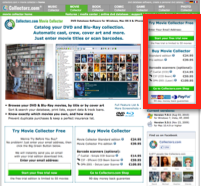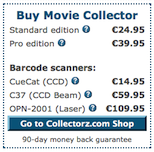 Earlier this week, Dave Collins asked for feedback on remarketing. I have already posted some remarks in the comments under his blog post, but then I thought, why not write about my experience with remarketing in a longer blog post. So here it is.
Earlier this week, Dave Collins asked for feedback on remarketing. I have already posted some remarks in the comments under his blog post, but then I thought, why not write about my experience with remarketing in a longer blog post. So here it is.
First, a quick reminder of what remarketing is:
Remarketing is a cookie-based advertising system that lets you show your ads to people who have already visited your website.
Your ads can appear on any site that the user visits after visiting yours.
For example: A user visits my Movie Collector product page (it doesn’t matter where he came from, an ad, organic result, a link on another website, etc…). Now after he visits my website, this user goes on to browse the internet, visiting other websites. And suddenly everywhere he goes, he sees Movie Collector ads. Leaderboards, towers, inline rectangles, even little text ads. My ads are following him around the web.
One important thing to understand: remarketing ads do not only appear on websites related to your product, like your regular display network ads. No, they appear everywhere, on any site. Remarketing lets you target specific users on any site, as opposed to all users on specific sites.
Remarketing for software
I started using Remarketing for our Collectorz.com software 2 years ago, when Adwords started offering it. Like most advertising and marketing tools, it didn’t work right out-of-the-box. It took a bit of tweaking and tuning to make it effective, but ultimately I found that remarketing can be a great fit for software vendors, especially if you use some kind of “try-before-you-buy” system.
Here’s some factors I played around with:
- Message
- Targeting, or: who to cookie?
- Audience Membership Duration and Frequency Capping
- Bidding type: CPC or CPA
- Reducing the creepiness
Let’s discuss these one by one: Continue reading →
 After running an A/B split test, when the results are in, you always have to make the decision:
After running an A/B split test, when the results are in, you always have to make the decision:
 For the past 2 years, our Movie Collector product page has shown a picture of me standing in front of my own DVD collection. Similarly, the Book Collector home had a picture of my wife Sytske and her book collection.
For the past 2 years, our Movie Collector product page has shown a picture of me standing in front of my own DVD collection. Similarly, the Book Collector home had a picture of my wife Sytske and her book collection. Earlier this week,
Earlier this week,  Through the years I have been experimenting with many different landing page designs and layouts. And there is one factor that’s consistently proving to improve conversion rates.
Through the years I have been experimenting with many different landing page designs and layouts. And there is one factor that’s consistently proving to improve conversion rates. Delivery on CD and Priority Support options, do you offer those up-sells “opt-in” or “opt-out”? In other words, when users click your Buy button, do you put these extras in their shopping cart automatically?
Delivery on CD and Priority Support options, do you offer those up-sells “opt-in” or “opt-out”? In other words, when users click your Buy button, do you put these extras in their shopping cart automatically?  Once in a while, I try to take a “fresh” look at my website. I just put one of our product pages on my screen, I sit back and try to imagine what it looks like for a new visitor, who just arrived there after a Google Search.
Once in a while, I try to take a “fresh” look at my website. I just put one of our product pages on my screen, I sit back and try to imagine what it looks like for a new visitor, who just arrived there after a Google Search.